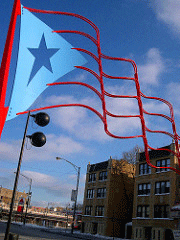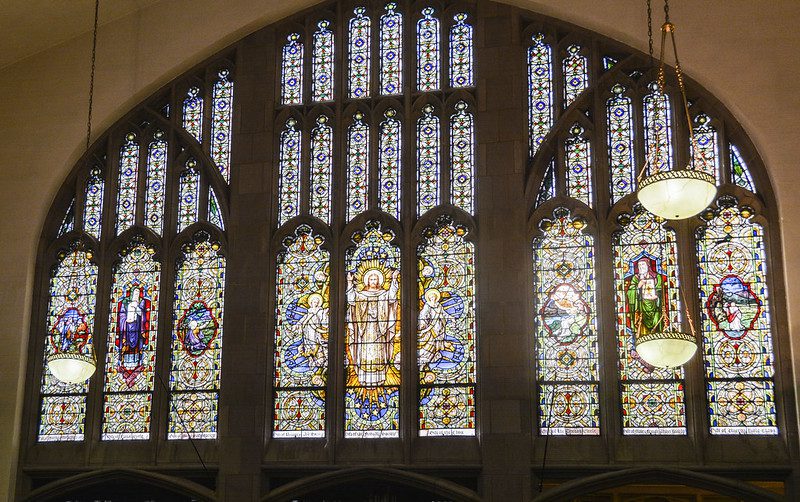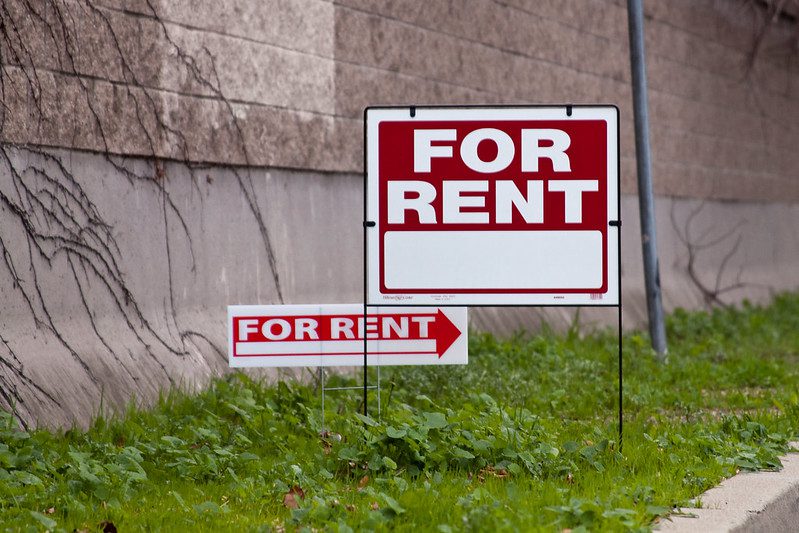
Photo courtesy of Vanessa Roanhorse via flickr, CC BY 2.0
In my prior post on Paseo Boricua, I referred to an old mural in Chicago’s Humboldt Park neighborhood that local activist Eduardo Arocho helped to save via a 10-year fight. A bit more about this mural:
The mural, first painted in 1971, is located on North Avenue, half a mile north of Paseo Boricua. Titled “La Crucifixion de Don Pedro,” the mural portrays Pedro Albizu Campos, the leader of the movement for Puerto Rican independence, affixed on a cross, centered between the white lines of the original national flag of Puerto Rico. Albizu Campos is flanked by two of his peers, including Lolita Lebron to his right, who is famous for opening fire in Congress in 1954.
The painting is shocking in its austerity, especially in juxtaposition to the intricate beauty of many of the murals that have been painted along Paseo Boricua in the last 25 years. Arocho remembers going past the mural as a child and being struck by the fact that “Jesus has a suit on.”
In 2001, plans were first unveiled for the development of a condominium project on the vacant lot adjacent to the mural, which happened to be around the same time that local groups began intensive plans for the mural’s restoration. Negotiations to trade vacant lots stalled. In 2003, one wall of the development was erected against the face of the mural overnight. Arocho and other organizational leaders organized large demonstrations and a press campaign in response, even going so far as to camp out on the site for 24 hours in order to halt development. The campaign proved successful. In 2005, the developer built to one story, and community groups again fought back successfully. In 2006, after the developer erected a two-story frame, Alderman Billy Ocasio threatened to chain himself to the structure, once again stalling construction in time to prevent development through legal channels.
In 2007, the City of Chicago met the demands of the protesters by assuming ownership of the lot via eminent domain. In 2010, it was leased to the longstanding Puerto Rican Cultural Center (PRCC), directed by polarizing community leader Jose Lopez. The mural was fully refurbished the next year, and the lot was converted into a community garden in 2012. In 2013, the lot was sold to PRCC for a dollar.
In his dissertation on Humboldt Park, Jesse Mumm cites ethnographer Rachel Rinaldo’s study of PRCC. Rinaldo argues that PRCC’s “success in defining Humboldt Park and fighting gentrification ‘emerges in large part from its incorporation of space and spatial strategies into its tactics of resistance.’” In this case, the spatial strategy was an 11-year effort to save a two-story wall.
In March of 2014, at the 60th Anniversary of Lebron’s attack, a message went up on a local community forum, complaining that the lot was closed too often, and the mural too expensive to restore:
“I am wondering if anyone has witnessed it open, as community space, as promised? Regardless of the not-so-subtle nuances of glorifying violence, promoting extremism, and deifying a terrorist, I think it should be open to the public…With the new coffee shop (Cup and Spoon Cafe) opening up a couple doors east in the coming months, I was thinking about how nice it would be to take a decent cup o’ joe there & witness the beauty of budding flowers, the greening of shrubs & native grasses, and to contemplate the transfiguration of a long, cold & icy Winter into the beauty of Spring while depictions of crucifixions loom over my shoulders.”
I cannot think of a better allegory for gentrification from the perspective of the common gentrifier—and then for the resistance that Rinaldo describes—than the last sentence of this passage.





Comments